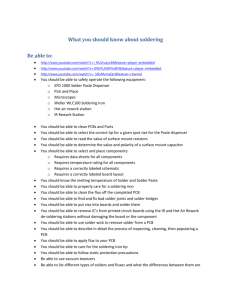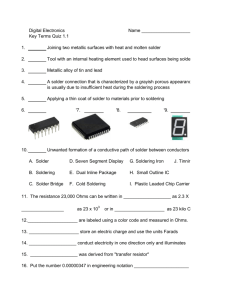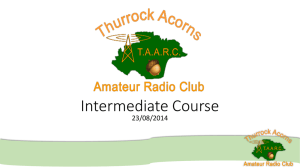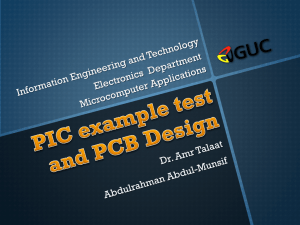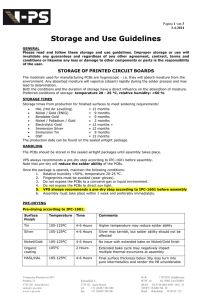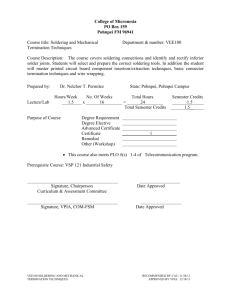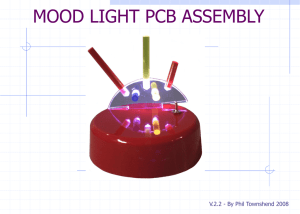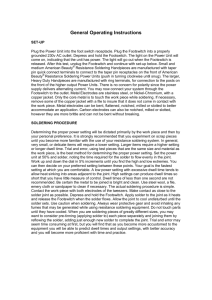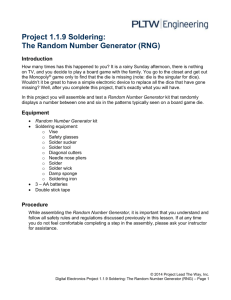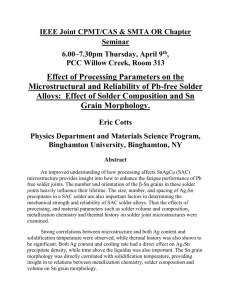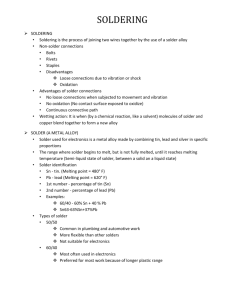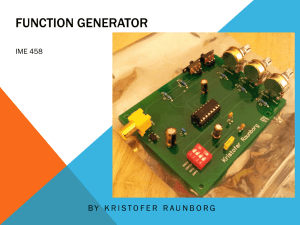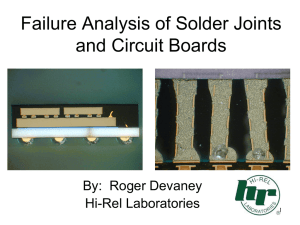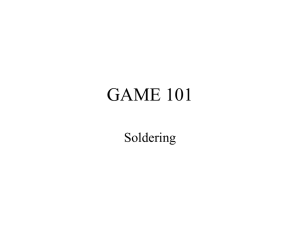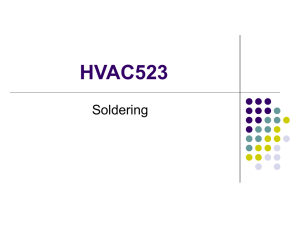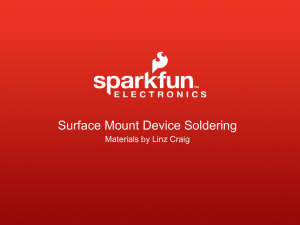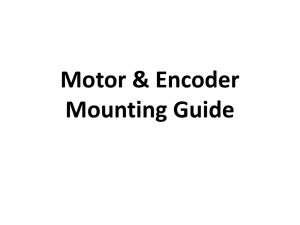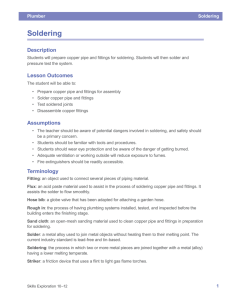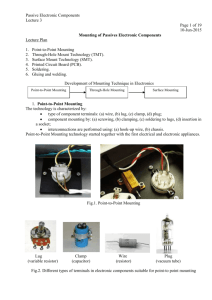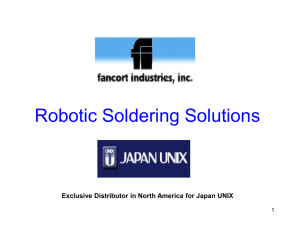EMS1EP Lecture 3 – Intro to Soldering
advertisement
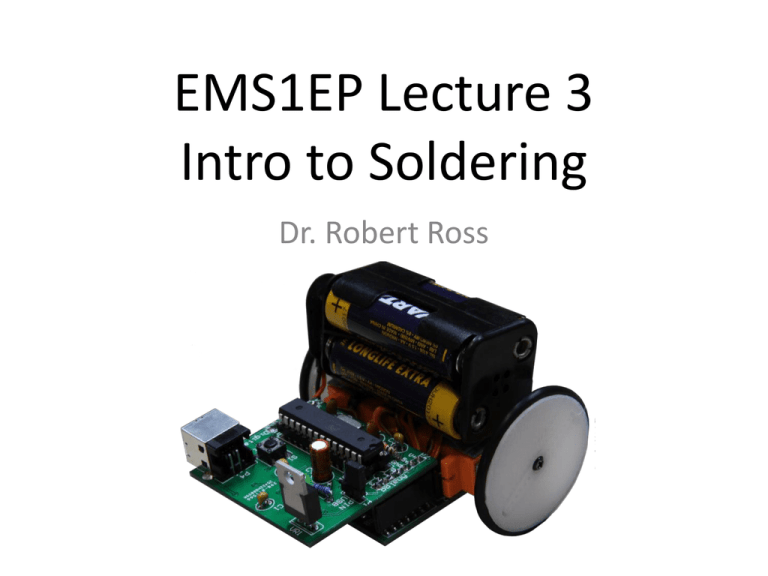
EMS1EP Lecture 3 Intro to Soldering Dr. Robert Ross Overview (what you should learn today) • What are Printed Circuit Board (PCB’s) – How PCB are made – Different types of PCBs • What is soldering • How to solder What are Printed Circuit Boards • PCBs consist of a surface which is plated with a conductive material (like copper) • Components can be soldered directly onto the conductive material – This supports components and connects them to each other to form a circuit Some PCB terms • Track: the copper traces between pads • Pad: what components are soldered to • Via: an electrical connections between different layers of the board • Footprint: the mechanical relationship between the pads for a specific component • Plane: not just traces but whole regions which connect pads together How PCBs are made Several different techniques, most common are: • Silk screen • Photo engraving • PCB milling As part of the process a drill is then used to create all the holes to put components and screws through Silk Screen PCB • Board (typically fiberglass FR4) is covered with a thin layer of copper foil • Any tracks and pads (copper we want to keep) is covered in etchresistant ink • The remaining copper is then chemically etched away Photoengraving • Copper layer on board is covered with a light-sensitive ink • A photomask is placed onto the board and the board is exposed to UV light • The remaining copper is then chemically etched away • Finer resolution compared to silk screening process PCB Milling • A 3-axis mechanical milling machine is used to cut away unwanted copper • High speed motor drives a cutting bit which cuts away the copper • Not as accurate and trickier for multi-layer PCBs • Automates hole drilling Solder Mask • Any part of the exposed copper can be soldered • Generally we only want to solder where we attach components • A solder mask (nonconductive layer) is added to the board leaving the solder pads exposed • Prevents oxidation and solder bridges between close tracks Overlay • An overlay can be applied over the solder mask • This is the writing which is useful for humans to read for assembly and maintenance • Generally using a silkscreen (white is the most common overlay colour) Multilayer PCBs • A single piece of fibreglass can be coated on the front and back with copper – this is a 2-layer PCB • For more layers boards can be made separately and laminated together • This gives more layers that tracks can be mounted on • Often whole layers are selected as ground layers which improves noise performance • Vias connect between the different layers • 4 and 6 layer boards are common, can go up to around 38 layers How PCBs are designed • Design schematic in CAD software (we use Altium) • Layout and route board in CAD software (Altium) • Many different routing possibilities • Auto routing • Guidelines: – Ground plane (avoid large loops) – Wider tracks for power – Avoid right angles What is soldering • Soldering is a way of making electrical connections • It involves melting solder (an alloy of tin and lead) to form a bond between the conductors on different components Soldering Precautions • Never touch the hot end of the soldering iron (~370oC) • If you do get burnt run your finger under cold water for 5 minutes • Don’t burn the table, the power leads, keyboards, your classmates • Don’t melt anything except solder • When not in use put the soldering iron back on the stand (not on the table) Soldering Precautions • Wear safety glasses, solder can flick into your eye • Wash your hands well after soldering (solder is 40% lead) • Use the fume extractors and don’t breath in the solder fumes How to solder • Hold the soldering iron like a pencil • Clean the soldering iron (wet sponge or brass strands) before you use it (if it hasn’t be used for more than 60 seconds) – it should look shiny How to solder • Hold the tip on the component lead and pad • Add solder and let it flow into the joint • Remove the solder • Remove the soldering iron and allow joint to cool (5 sec) before moving anything Soldering Video Demo • http://www.youtube.com/watch?v=euw9tkxBgus Soldering inspection Through-hole/Surface Mount • 2 types of components: – Through hole: have leads which pass through holes on the PCB and are soldered on other side – Surface Mount (SMT) soldered onto the same side of the PCB that the component is on • SMT tends to be much smaller allowing greater miniaturisation of electronics Desoldering • If something goes wrong – don’t worry solder will remelt • Techniques to removing components: – Reheat and pull component out – Desoldering braid (braid draws solder away from joint) – Desoldering gun (sucks hot solder from joint) – Hot air (heats all the pads using hot air) Summary (What you learnt in this session) • Printed Circuit Boards (PCBs) are the most common method used to implement electronic circuits • Soldering is how we make the electrical connections between components and the PCB

